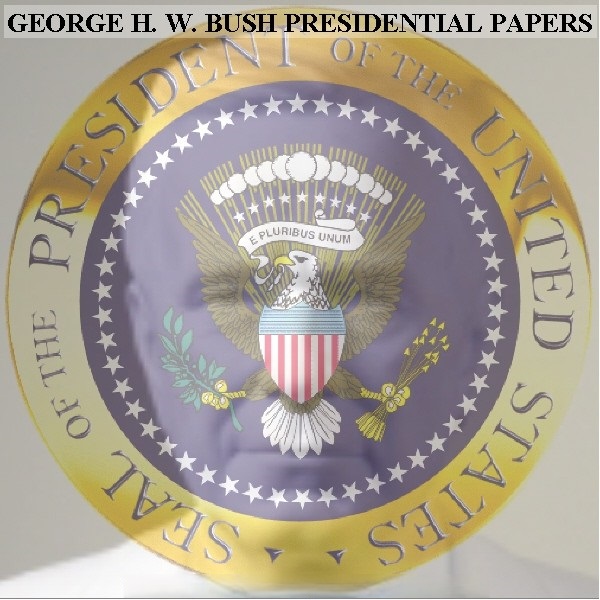
Description
George H.W. Bush: A Detailed Timeline
Detailed Timeline of Events (Based on Provided Source)
World War II Era:
- 1942: George H.W. Bush enlists in the U.S. Navy.
- June 1943: George H.W. Bush receives his wings and commission, becoming the youngest pilot in the Navy at the time (age 18).
- August 1942 – September 1945: George H.W. Bush serves in World War II, flying torpedo bombers off the USS San Jacinto.
- September 2, 1944: While on a bombing run over Chichi Jima (Bonin Islands), George H.W. Bush’s plane is hit by anti-aircraft fire. He completes his strafing run before bailing out. His two crew members are killed.
- September 2, 1944: George H.W. Bush is rescued by the U.S. Navy submarine USS Finback.
Post-World War II and Early Political Career:
- Post-WWII: George H.W. Bush enters Yale University.
- 1964: George H.W. Bush unsuccessfully bids for a U.S. Senate seat.
- 1966: George H.W. Bush is elected to the U.S. House of Representatives.
- 1970: George H.W. Bush loses a second campaign for the U.S. Senate.
- 1971: George H.W. Bush is named U.S. Ambassador to the United Nations.
- 1971 – 1991: Dates covered by the Department of State files related to George Bush’s diplomatic activities.
- 1973: George H.W. Bush becomes Chairman of the Republican National Committee.
- October 1974: George H.W. Bush travels to Peking (now Beijing).
- October 21, 1974 – August 22, 1975: George H.W. Bush serves as Chief of the U.S. Liaison Office in Peking, documented in his “China Diary.”
- 1975 – 1997: Dates covered by CIA files related to George Bush’s involvement.
- 1976: George H.W. Bush is appointed Director of the Central Intelligence Agency (CIA).
- 1980: Ronald Reagan selects George H.W. Bush as his running mate.
- January 20, 1981: George H.W. Bush is sworn in as Vice President of the United States, serving two terms.
Presidency (1989-1993):
- January 20, 1989: George H.W. Bush is inaugurated as the 41st President of the United States. He issues a National Security Directive providing the charter for NSC administration.
- 1989 – 1992: Period covered by Bush Administration National Security Directives, addressing topics such as the collapse of the USSR, German unification, Operation Just Cause (Panama), and Operations Desert Shield and Desert Storm (Persian Gulf).
- 1989 – 1993: Period covered by Bush Administration National Security Reviews, addressing general national security and foreign policy issues.
- December 1989: Operation Just Cause: American troops are sent into Panama.
- January 1991 – February 27, 1991: Period covered by the Presidential Logs, documenting daily activities during Operation Desert Storm (Persian Gulf War), including briefings and contacts with coalition leaders.
- January 15, 1991 – February 27, 1991: Operation Desert Storm (Persian Gulf War) takes place.
- 1989, 1990, 1991: Years for which President Bush’s tax returns are included in the papers.
- 1989 – 1992: Dates mentioned in the context of NSC machinery reform under President Bush.
- Unspecified Date (Bush Presidency): President Bush meets with the Dalai Lama.
- 1992: George H.W. Bush loses his re-election bid to Bill Clinton.
- Post-Presidency: CIA files dating up to 1997 mention George Bush, suggesting continued involvement or documentation related to his time as Director.
Specific Events and Issues Mentioned:
- Tiananmen Square Crisis: Memos written before, during, and after the crisis are included in the CIA files (likely around 1989). Department of State files also relate to the Tiananmen Square demonstrations.
- El Salvador, Latin America, Haiti: Memos and telegrams related to George Bush and diplomatic issues involving these regions are found in the Department of State files.
- Nicaragua and Nicaraguan Resistance: National Security Directives cover U.S. policy towards these.
- Cocaine Trafficking and International Counter-narcotics Strategy: Addressed in National Security Directives.
- U.S. Policy Towards Panama Under Noriega: Covered in National Security Directives.
- Chemical Weapons Arms Control Initiative: Subject of National Security Directives.
- U.S. Policy Toward February 1990 Nicaraguan Election: Addressed in National Security Directives.
- U.S. Policy Toward the Persian Gulf: Covered in National Security Directives.
- Soviet Emigration Policy: Addressed in National Security Directives.
- U.S.-Soviet Economic Initiatives: Subject of National Security Directives.
- Iraqi Invasion of Kuwait: A key event during Bush’s presidency, covered by National Security Directives and the Presidential Log during Operation Desert Storm.
- Nuclear Weapons Deployment: Addressed in National Security Directives.
- Taiwan’s application for membership in GATT, trade issues, arms sales, and general relations: Topics covered in the Taiwan Diplomatic Documents.
- Alleged Chinese violations of human rights in Tibet: Correspondence concerning this is included in the Tibet – Dalai Lama Documents.
- Iran-Contra Affair Pardons: Pardons of several individuals related to this affair are documented.
Cast of Characters and Brief Bios
- George Herbert Walker Bush: (Born June 12, 1924) 41st President of the United States (1989-1993). Served as a U.S. Navy pilot in World War II, Congressman, U.S. Ambassador to the United Nations, Chairman of the Republican National Committee, Chief of the U.S. Liaison Office in Peking, Director of the Central Intelligence Agency, and Vice President under Ronald Reagan.
- Dorothy Walker Bush: Mother of George H.W. Bush.
- Prescott Bush: Father of George H.W. Bush.
- William Colby: Director of the Central Intelligence Agency prior to George H.W. Bush.
- Gerald Ford: 38th President of the United States. George H.W. Bush served in his administration as Director of the CIA.
- Jimmy Carter: 39th President of the United States. George H.W. Bush oversaw intelligence briefings for him as the outgoing CIA Director.
- Ronald Reagan: 40th President of the United States. George H.W. Bush served as his Vice President for two terms.
- Bill Clinton: 42nd President of the United States, who defeated George H.W. Bush in the 1992 election.
- Frank Carlucci: Served as National Security Advisor under President Reagan and played a role in reforming the NSC machinery.
- Colin Powell: Served as Chairman of the Joint Chiefs of Staff under President George H.W. Bush and was involved in the foreign affairs events of the Reagan Administration and the NSC reforms.
- Brent Scowcroft: National Security Adviser to President George H.W. Bush. He had previous experience in the Kissinger National Security Council, as National Security Adviser under President Ford, and chaired the President’s Board examining the Iran-Contra scandal.
- Robert Gates: Deputy National Security Adviser under Brent Scowcroft until his appointment as Director of Central Intelligence in 1991.
- Madame Chiang Kai-shek: Wife of the former President of the Republic of China. Correspondence from her is included in the Taiwan Diplomatic Documents.
- Dalai Lama: The spiritual leader of Tibetan Buddhism. Documents cover his relationship with the United States and China, including President Bush’s meeting with him.
- Robert McFarlane, Caspar Weinberger, Elliot Abrams, Duanne Clarridge, Alan Friars, Clair George: Individuals pardoned by President Bush in relation to the Iran-Contra Affair.
- Manuel Noriega: Leader of Panama during the period of Operation Just Cause.
- Saddam Hussein: President of Iraq during the Persian Gulf War.
- Crew Members of George H.W. Bush’s downed plane: Two unnamed crew members who were killed on September 2, 1944.
George Herbert Walker Bush Presidential Papers
18,257 pages of George H. Bush, 41st president of the United States and Bush Administration papers.
George Herbert Walker Bush, 41st president of the United States, was born on June 12, 1924, in Milton, Massachusetts, to Dorothy Walker Bush and Prescott Bush. In 1942, he enlisted in the U.S. Navy. In June 1943 while still18 years old, he was the youngest pilot in the Navy at that time. George Bush was awarded the Distinguished Flying Cross and three Air Medals. George Bush entered Yale University after World War II.
Following an unsuccessful bid for a Senate seat in 1964, Mr. Bush was elected to the U.S. House of Representatives in 1966. George Bush lost a second campaign for the Senate in 1970.I n 1971, he was named U.S. Ambassador to the United Nations. He served there until 1973, when he became Chairman of the Republican National Committee. In October 1974, George Bush traveled to Peking, where he served as Chief of the U.S. Liaison Office. In 1976, George Bush was appointed Director of the Central Intelligence Agency (CIA) . In 1980, Ronald Reagan selected George Bush to be his running mate. On January 20, 1981, George Bush was sworn in for the first of two terms as Vice President. In 1988. George Bush became the 41st President of the United States in 1989. Bush lost his 1992 re-election bid to Bill Clinton
Materials Include:
CIA FILES
150 pages of CIA files dating from 1975 to 1997. Documents include: A letter written to CIA Director William Colby, whom Bush will be replacing; Memo from George Bush to President Gerald Ford concerning his views of the role of the Director of Central Intelligence and the CIA; Notes made by Bush after briefings made to President Ford; Legislation concerning electronic surveillance; Request to CIA employees that they report any illegal CIA activity; Memos concerning intelligence briefings given to president elect Jimmy Carter; Bush’s handwritten letter of resignation; Memos written before, during ,and after the Tiananmen Square crisis.
DEPARTMENT OF STATE FILES
124 pages of Department of State files dating from 1971 to 1991. Memos and telegrams related to George Bush and diplomatic issues involving El Salvador, China, Tiananmen Square demonstrations, Latin America issues, and Haiti.
CHINA DIARY
330 pages of diary entries made by George Bush. The “China Diary” is a chronicle of George H.W. Bush’s personal thoughts while head of the U.S. Liaison Office in Peking (now Beijing), China. The diary begins on 21 October 1974 and ends on 22 August 1975. The diary contains George Bush’s reactions to all aspects of life in Peking, including his opinions of public officials and diplomats, politics, family matters, international affairs, and life in China.
NATIONAL SECURITY DIRECTIVES
279 pages of Bush Administration National Security Directives, 1989-1992.
After serving 8 years as Vice President and participating in the foreign affairs events of the Reagan Administration, President George Bush made many changes in the NSC machinery reformed by Frank Carlucci and Colin Powell. On the date of his inauguration, January 20, 1989, President Bush issued a NSD providing the charter for NSC administration. A Policy Review Group was enlarged to a Committee, the Deputy National Security Adviser managed the Deputies Committee, and a Principals Committee screened matters for the NSC to consider. Eight Policy Coordinating Committees assumed regional and functional responsibilities in place of the multiple interagency groups from the Reagan era. NSC policy papers were named National Security Review papers (NSRs) and National Security Directives (NSDs) to distinguish them from the Reagan era documentation.
President Bush appointed General Brent Scowcroft as National Security Adviser. Scowcroft had served in the Kissinger National Security Council, had been National Security Adviser in the last years of the Ford administration, and had chaired the President’s Board examining the Iran-Contra scandal. Robert Gates served as Deputy National Security Adviser under Scowcroft until his appointment as Director of Central Intelligence in 1991. The directives document the course of national security decisions through the collapse of the USSR and the unification of Germany, Operation Just Cause which sent American troops into Panama in December 1989, and Operation Desert Shield and Desert Storm. The National Security Directives also cover: U.S. Policy Toward Nicaragua and Nicaraguan Resistance; Cocaine Trafficking and International Counter-narcotics Strategy; U.S. Policy Towards Panama Under Noriega; Chemical Weapons Arms Control Initiative; U.S. Policy Toward February 1990 Nicaraguan Election; U.S. Policy Toward the Persian Gulf; Soviet Emigration Policy; U.S.-Soviet Economic Initiatives; Iraqi Invasion of Kuwait; and Nuclear Weapons Deployment.
NATIONAL SECURITY REVIEWS
85 pages of Bush Administration National Security Reviews from 1989 to 1993. These reviews address general issues concerning national security and U.S. foreign policy. Topics include: Intelligence Capabilities 1992-2005; Review of U.S. Government International Broadcasting Activities; Review of United States Non-Proliferation Policy; Counterintelligence and Security Countermeasures; U.S. Policy Toward Lebanon; Review of U.S. Arms Control Policies; and Review of National Defense Strategy.
PRESIDENTIAL LOG
400 pages of Presidential logs from January 1991 to February 27, 1991. The diary entries from January 15, 1991 to February 27, 1991 cover the period of Operation Desert Storm, otherwise known as the Persian Gulf War. The entries document the President’s daily intelligence and national security briefings and his frequent contacts with the heads of state of coalition partners. The White House Office of Appointments and Scheduling maintains the Presidential Daily Diary. The daily diary logs the daily activities of the President, including personal and private meetings (with lists of attendees), events, social and speaking engagements, trips, telephone calls, meals, routine tasks, and recreational pursuits. For any given meeting, telephone call, or event, the daily diary usually lists the time, location, persons involved (or a reference to an appendix listing individuals present), and, in cases where ambiguity prevails, a brief description of what took place. Everything is logged from the president getting a hair cut in the White House barber shop to war cabinet meetings in the White House Situation Room
PUBLIC PAPERS
15,000 pages of text transcription of President George Bush public papers, January 20, 1989 – January 19, 1993. Nearly every public word spoken or issued by President Bush. The material includes Presidential proclamations, speeches, transcripts of press conferences, transcripts of press briefing by the president’s press secretary, remarks at travel stops, television and radio addresses, communications to Congress and Federal agencies, statements regarding bill signings and vetoes, appointments, nominations, reorganization plans, resignations, retirements, acts approved by the President, nominations submitted to the Senate, White House announcements, State of the Union addresses and press releases.
TAIWAN DIPLOMATIC DOCUMENTS
1,000 pages of documents related to Taiwan, including correspondence from Madame Chiang Kai-shek. Material deals with issues such as Taiwan’s application for membership in GATT, trade issues, arms sales, and general relations. Researchers should note that since the United States transferred official recognition from Taiwan to the People’s Republic of China in 1979, the American Institute in Taiwan (AIT) (under contract to the Department of State) became the contact point for communications between the U.S. and Taiwan. Taiwan’s contact in the U.S. was the Coordination Council for North American Affairs (CCNAA). Material includes routine letters from the public and Congress, and routine memoranda within the Administration.
TIBET – DALAI LAMA DOCUMENTS
38 pages of documents covering Tibet, the Dalai Lama and his relationship with the United States and China. Much of the material consists of correspondence concerning alleged Chinese violations of human rights in Tibet with appeals for the United States to take a more active role in preventing Chinese abuses. Contains information on the President’s meeting with the Dalai Lama and background information on Tibet.
PARDONS
7 pages of documents, proclamations and explanations related to the Iran-Contra Affair pardons of Robert McFarlane, Caspar Wienberger, Elliot Abrams, Duanne Clarridge, Alan Friars, and Clair George.
TAX RETURNS
82 pages of tax returns filled by President Bush for 1989, 1990, and1991.
WORLD WAR II DOCUMENTS
In 1942, George Bush enlisted in the U.S. Navy. Receiving his wings and commission in June 1943 while still 18 years old, he was the youngest pilot in the Navy at that time. George Bush served during World War II from August 1942 to September 1945. George Bush flew torpedo bombers off the USS San Jacinto. On September 2, 1944, Mr. Bush’s plane was hit by anti-aircraft fire while making a bombing run over the Bonin Island of Chichi Jima, 600 miles south of Japan. Although the plane was afire and severely damaged, he completed his strafing run on the targeted Japanese installation before flying towards sea to bail out. Mr. Bush was able to bail out successfully and was rescued by a Navy submarine, the USS Finback. Bush’s two crew members were killed.
15 pages of documents and photos from World War II. U.S. Submarine War Patrol Report, USS Finback (SS-230), 10th War Patrol, September 2, 1945. This war patrol report entry includes the rescue of George Bush after the eventual president’s aircraft was downed over the ocean during World War II. Action Report, U.S. Navy Torpedo Squadron 51 (VT-51), for Actions Occurring September 1-2, 1944. This is the action report of the air squadron (VT-51) of George Bush covering his rescue on September 2, 1944. Bush was rescued after his TBM-1C aircraft was downed over the ocean. Deck Log of USS Finback (SS-230), September 2, 1944. This deck log entry notes the rescue of George Bush by the USS Finback. Deck Log of USS San Jacinto (CVL-30), September 2, 1944. This deck log entry notes that George Bush was taken aboard the USS San Jacinto. World War II Casualty List by Aircraft Type, TBM1C, September 2, 1944. This casualty list notes the loss of the TBM-1C aircraft of George Bush over the ocean on September 2, 1944.
Includes a photograph of George Bush in the cockpit of his TBM Avenger during World War II, George Bush being rescued by the submarine, the U.S.S. Finback, after being shot down while on a bombing run of the Island of Chi Chi Jima.






Related products
-
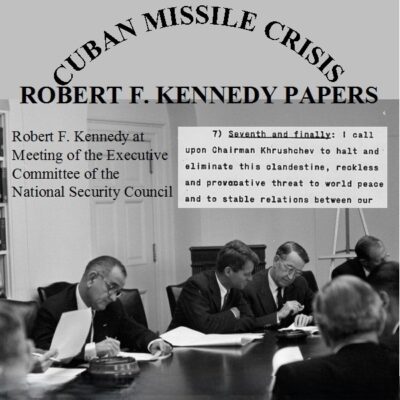
Cuban Missile Crisis: Robert F. Kennedy Papers
$19.50 Add to Cart -
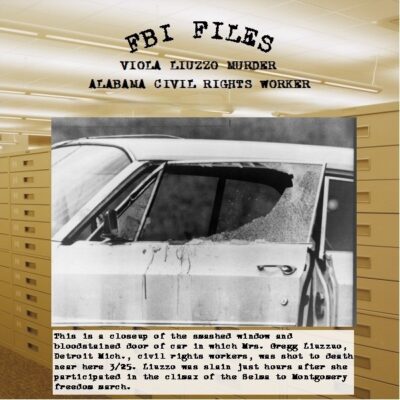
Viola Liuzzo Murder – Alabama KKK FBI Files – President Johnson Secret Phone Recordings
$19.50 Add to Cart -
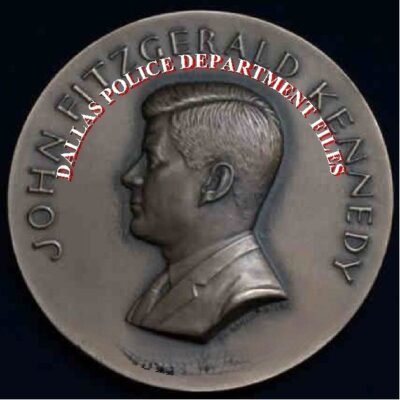
John F. Kennedy Assassination Dallas Police Department Files
$19.50 Add to Cart -
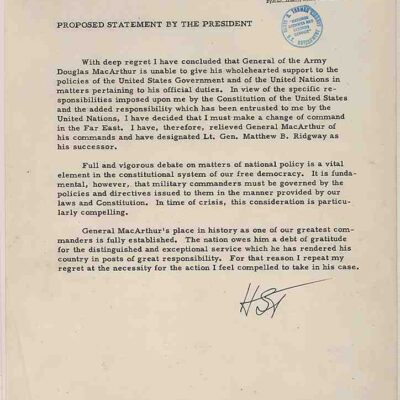
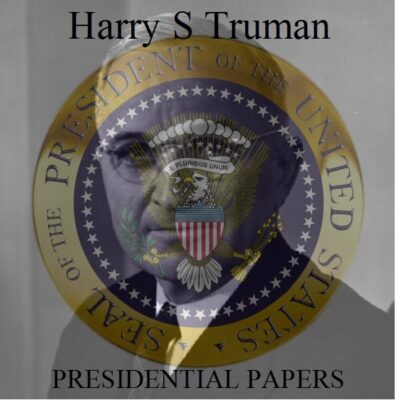
Harry S Truman Presidential Papers
$19.50 Add to Cart